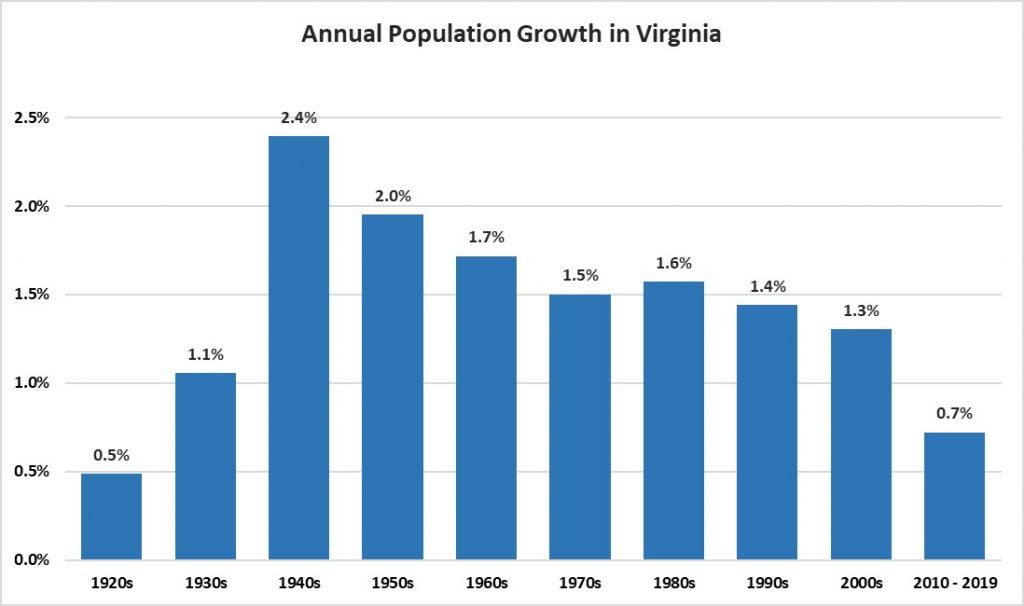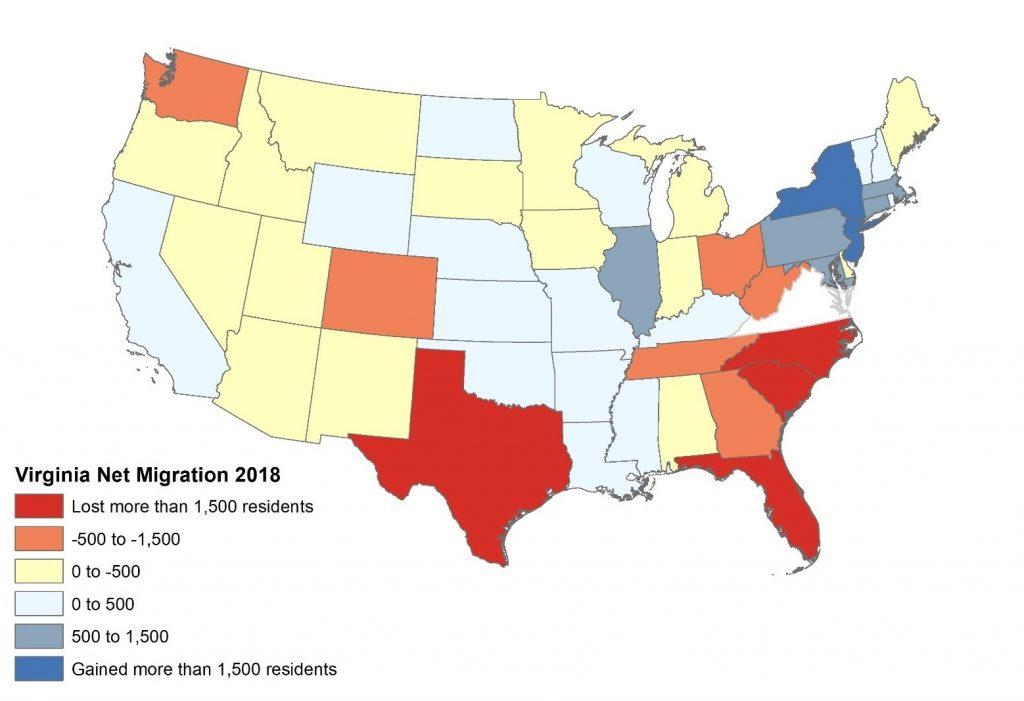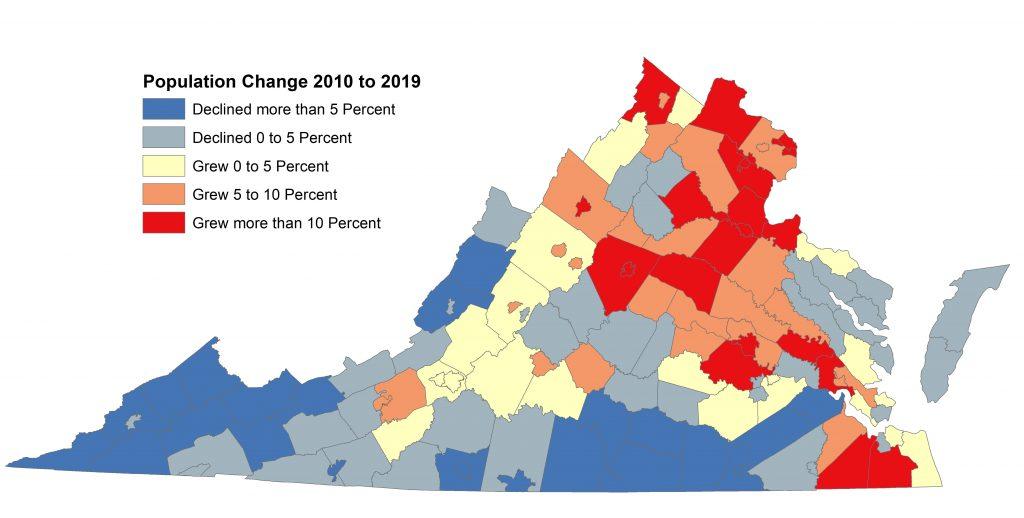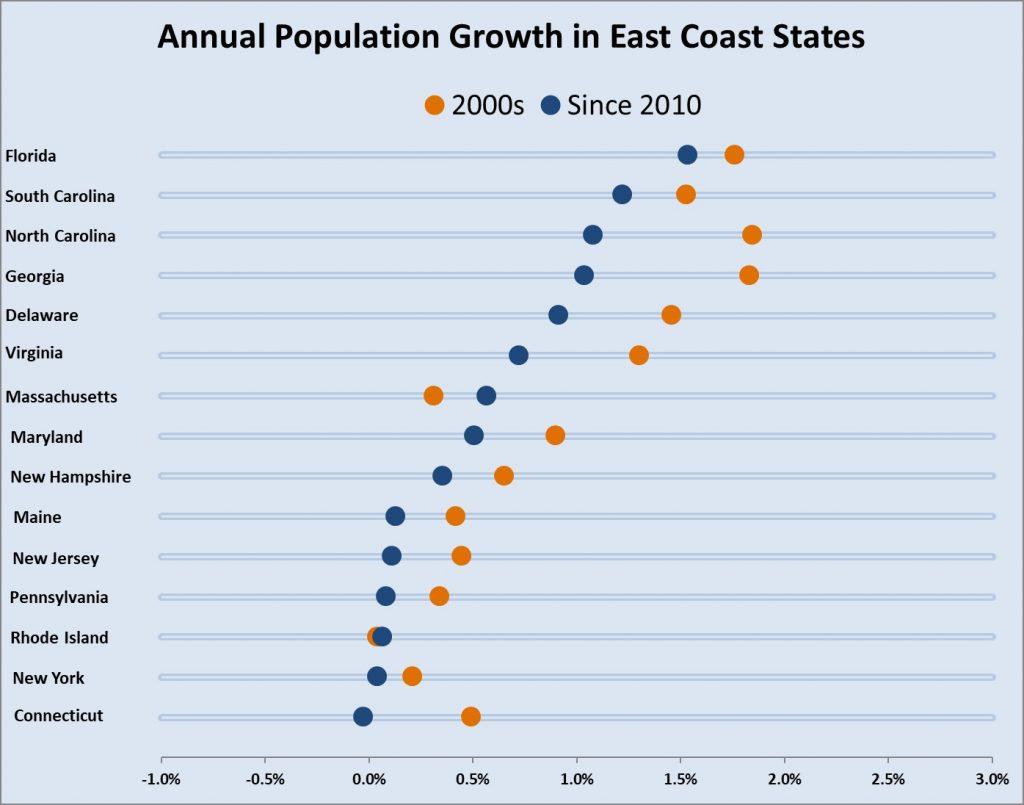Population growth in Virginia slowest in a century as out-migration continues
This morning the Weldon Cooper Center at the University of Virginia released its 2019 population estimates for Virginia’s counties and cities. The estimates show Virginia’s population inched up to 8,535,519 in 2019, after passing 8.5 million in 2018. Though Virginia has added over half a million new residents since the last census in 2010, population growth has slowed significantly across Virginia in recent years, falling below U.S. growth levels to reach the lowest population growth rate since the 1920s.

Similar to the 1920s, Virginia’s population is growing more slowly because for the past six years, the number of Virginians moving out of the commonwealth has been greater than the number of people moving to Virginia from other states. During the 1920s, the increasing mechanization of agriculture caused thousands of Virginians to move out of the countryside, often to Northeastern cities to find work. Today, migration patterns have reversed, with Virginia attracting thousands of new residents every year from the Northeast but losing an even larger number of Virginians who have moved south to fast growing metro areas and popular retirement communities. In 2018, the most recent year IRS migration data is available, nearly 15,000 more Virginians moved to either Florida, the Carolinas or Texas than residents of those states moved to Virginia.
Virginia 2018 Net Migration to Other States

The recent shift in Virginia to out-migration has been driven, just as during the 1920s, by changes within Virginia’s economy, principally Northern Virginia’s economy. Decades of above average economic growth in the Washington DC area, in large part due to the expansion of the federal government, attracted hundreds of thousands of people to the region, fueling the majority of Virginia’s population growth by the 1980s. In 2010, 10 of the 15 counties with the highest median household incomes in the U.S. were located in the Washington DC area. But for much of the 2010s, economic growth in the DC area has lagged the rest of the U.S., in part due to the Federal Budget Sequestration. By 2018, the number of DC area counties that were among the top 15 wealthiest U.S. counties had fallen to 5 as an increasing number of residents moved out of the region to other states.

Though the increasing number of residents leaving Northern Virginia has slowed its population growth, Northern Virginia has still managed to grow faster than any other Virginia metro area this decade as a result of its disproportionately young population; in 2018 Northern Virginia had nearly 24,000 more births than deaths. Outside of Northern Virginia, an aging population in most counties has caused slower population growth and decline as the birth-death balance shrunk to 6,600 in 2018 from 20,000 ten years earlier. In 2018, 64 of Virginia’s 95 counties had more deaths than births in 2018, up from 37 in 2008.

Even with considerably less population growth in Virginia during the 2010s than in the 2000s, the geographic distribution of growth has been fairly consistent across recent decades. In both decades, communities relatively near Northern Virginia or with a large university were the most likely to grow, and many rural counties lost population, while suburban localities experienced most of the growth in Virginia. In 2019, a couple Virginia localities passed notable demographic milestones that illustrate the continuity in Virginia’s population trends across recent decades. Chesapeake City, a suburb of Norfolk and less than half its size in population as recently as the 1980s, surpassed Norfolk in 2019 to become the second largest city in Hampton Roads. Likewise, Montgomery County, home to Virginia Tech, passed 100,000 in population last year, making Montgomery County the largest county or city west of the Blue Ridge Mountains.
The remarkable slowdown in Virginia’s population growth during the 2010s and the shift to out-migration for the first time since World War II made the last decade’s population trends arguably the most distinct in a century (although slowing population growth is a trend that most other states have also experienced this decade). As both the U.S. and the global population age, U.S. and global growth rates have slowed, both falling by half since the 1970s. What has made Virginia’s demographic trends distinct in the 2010s is the extent of its slowdown in population growth and its inability to keep attracting enough newcomers to make up for those leaving Virginia.

During the 2010s, six states managed to start the decade growing faster than the U.S. and attracting residents from other states, only to end the decade growing slower than the U.S. and losing residents to other states. Virginia and Maryland were two of the states, while the other four were Alaska, New Mexico, North Dakota and Oklahoma—four of the top five oil producing states in the U.S. As more of Virginia’s population lives in Northern Virginia, the commonwealth will likely need to become more used to booms and busts in population growth, just as other states have whose economies are dependent on a single industry.


